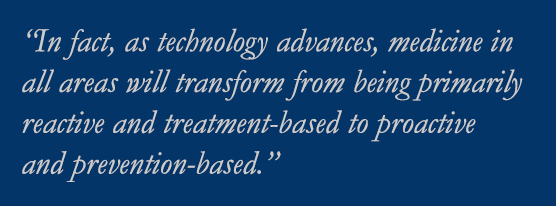There’s an emerging science known as “Neuroprediction” which uses data derived from brain-imaging studies to predict future outcomes and behavior. The idea is that certain findings on brain scans correlate with certain behavioral or neurologic outcomes. For example, a recent article establishes a link between amygdala hyper-activation and those who later will develop depression.
“This study investigated whether amygdala reactivity in a sample of men at the transition to adulthood predicted depressive symptomatology 2 years later. Bilateral amygdala activation in response to neutral facial expressions at age 20 predicted depressive symptoms at age 22. These results remained significant when we controlled for depressive symptoms at age 20. These findings suggest that in a large and diverse community sample of men amygdala hyper-activation may help identify those who will go on to experience worse depression 2 years later.”[1]
This article made it clear how the viewing of a neutral facial expression served as the means to elicit this particular finding: “Contrary to previous findings indicating alterations in reactivity to negatively valenced facial expressions in depression, amygdala reactivity had the strongest predictive effects in response to neutral facial expressions. This prediction to depressive symptoms may indicate that individuals who go on to have more severe depressive symptoms are biased toward increased amygdala processing of neutral facial expressions.”[2]
As this science develops, it’s only a matter of time before experts in neuroprediction will be called in personal injury cases to establish future cognitive and neurological damages. Certain head  injuries, for instance, may predispose a patient to future depressive symptoms and testimony by experts in neuroprediction will be used to establish those future damages. As well, life care planners will rely on neuroprediction reports to calculate the cost of future medical, psychiatric, and therapeutic care. Illinois recognizes “risk of future injury” as an element of damage, and this type of testimony fits well within that framework. (IPI 30.04.03)
injuries, for instance, may predispose a patient to future depressive symptoms and testimony by experts in neuroprediction will be used to establish those future damages. As well, life care planners will rely on neuroprediction reports to calculate the cost of future medical, psychiatric, and therapeutic care. Illinois recognizes “risk of future injury” as an element of damage, and this type of testimony fits well within that framework. (IPI 30.04.03)
With regard to the actual treatment of patients, there may be others uses. Writes Abigail Marsh:
“Neuroprediction may yield solutions to these problems. One recent study found that the relative efficacy of different treatments for depression could be predicted from a brain scan measuring metabolic activity in the insula. Another found that predictions about whether paroled offenders would recidivate were improved using a brain scan that measured hemodynamic activity in the anterior cingulate cortex. Neither approach is ready for widespread use yet, in part because predictive accuracy at the individual level is still only moderate, but inevitably they––or improvements on them––will be. This would be an enormous advance in mental health. Currently, treatment outcomes for disorders like depression remain poor; up to 40 percent of depressed patients fail to respond to the first-line treatment, the selection of which still relies more or less on guesswork. Using neuroprediction to improve this statistic could dramatically reduce suffering.”[3]
One can easily envision patient treatments being instituted prior to the development of symptoms based on the science of neuroprediction. In fact, as technology advances, medicine in all areas will transform from being primarily reactive and treatment-based to proactive and prevention-based.
So too in law. In particular, tort law, as traditionally practiced, is reactive––eventually it will become both reactive and proactive. Accident cases primarily focus on the past; eventually they will focus on both the past and the future. In the not too distant future, cases will routinely be brought to compensate for past harm as well as to prevent future harm from occurring––just as in medicine, law recognizes optimal health to be the ultimate goal.
[1] Whitney I. Mattson, Luke W. Hyde, Daniel S. Shaw, Erika E. Forbes, Christopher S. Monk, Clinical neuroprediction: Amygdala reactivity predicts depressive symptoms 2 years later, Soc Cogn Affect Neurosci. 2016 Jun; 11(6): 892–898. https://www.ncbi.nlm.nih.gov/pmc/articles/PMC4884317/
[2] Id.
[3] Abigail Marsh, Neuroprediction, in Know This: Today’s Most Interesting and Important Scientific Ideas, Discoveries, and Developments, Pg 482 (Editor, John Brockman)(Harper Collins 2017).




